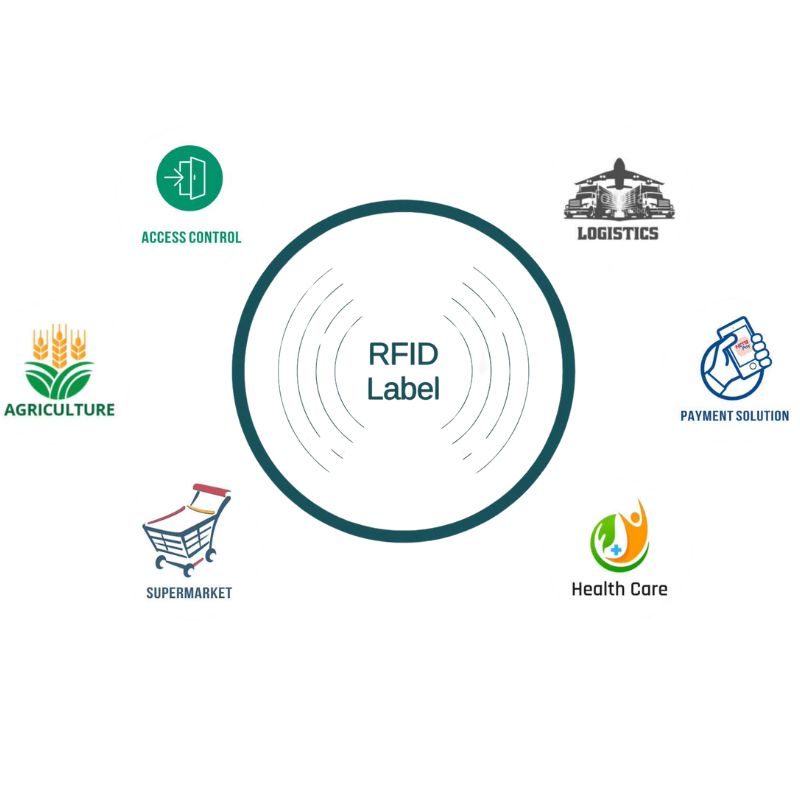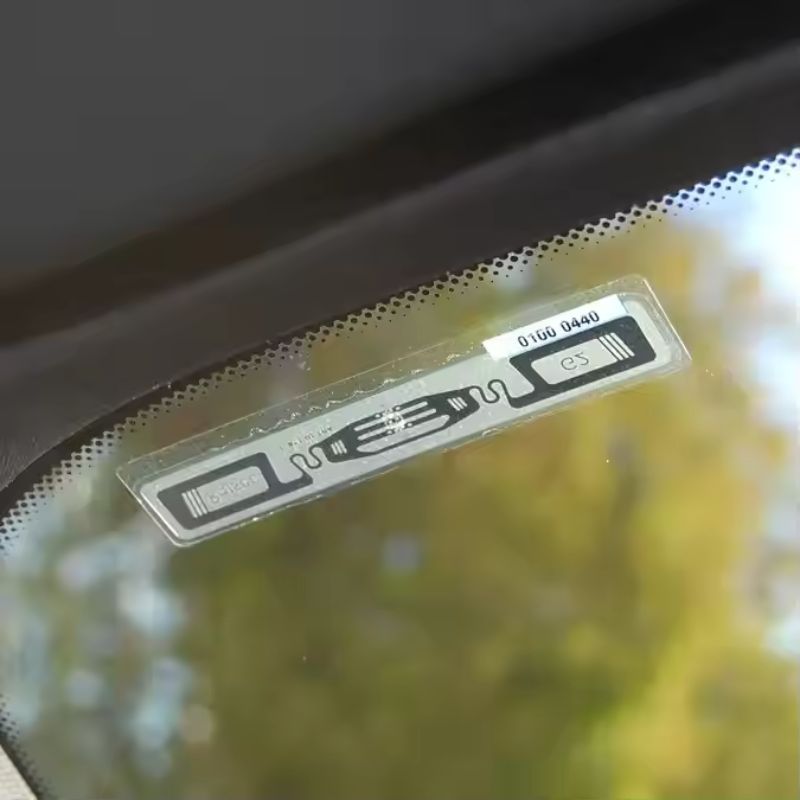
RFID Labels: The Future of Tracking and Identification
Table of Contents
Summary
This comprehensive guide will explore what RFID labels are, how they work, and the numerous benefits they offer across various industries. Whether you’re new to RFID technology or looking to expand your knowledge, this article will provide valuable insights into the world of RFID labels and their applications.

What Are RFID Labels and How Do They Work?
RFID labels, also known as RFID tags, are small electronic devices that use radio waves to transmit information. Unlike traditional barcodes, RFID labels don’t require a direct line of sight to be read, making them more versatile and efficient for tracking and identification purposes.An RFID label typically consists of two main components:
- RFID chip: This tiny microchip stores and processes data.
- Antenna: This component enables the chip to communicate with RFID readers.
When an RFID reader sends out radio waves, the antenna in the RFID label captures this energy and powers up the chip. The chip then transmits its stored information back to the reader, allowing for quick and accurate identification.
What Are the Different Types of RFID Tags?
There are several types of RFID tags, each with its characteristics and applications:
- Passive RFID tags: These tags don’t have their power source and rely on the energy from the reader to function. They’re smaller, cheaper, and have a shorter read range.
- Active RFID tags: These tags have their battery, allowing for longer read ranges and the ability to continuously transmit data. They’re larger and more expensive than passive tags.
- Semi-passive RFID tags: These tags have a battery to power the chip but still rely on the reader’s energy for communication.
- UHF RFID tags: Ultra-high frequency tags offer longer read ranges and faster data transfer rates, making them ideal for supply chain and inventory management.
- HF RFID tags: High-frequency tags are commonly used for access control and payment systems.
- LF RFID tags: Low-frequency tags have shorter read ranges but are less susceptible to interference from metals and liquids.
What Are the Benefits of Using RFID Labels?
RFID labels offer numerous advantages over traditional tracking methods:
- Improved efficiency: RFID labels can be read quickly and in bulk, streamlining inventory processes.
- Enhanced accuracy: The technology reduces human error in data entry and tracking.
- Real-time tracking: RFID systems provide up-to-date information on asset locations and movements.
- Increased visibility: Businesses gain better insights into their supply chain and inventory levels.
- Reduced labor costs: Automation of tracking processes leads to significant time and cost savings.
- Improved customer satisfaction: Accurate inventory management ensures products are available when needed.
How Do RFID Labels Compare to Barcodes?
While barcodes have been the standard for inventory tracking for decades, RFID labels offer several advantages:
Feature | RFID Labels | Barcodes |
Read Range | Up to several meters | Line of sight required |
Data Capacity | Large (up to 8KB) | Limited |
Read Speed | Multiple tags simultaneously | One at a time |
Durability | Resistant to environmental factors | Can be easily damaged |
Rewritability | Can be updated and rewritten | Static information |
Cost | Higher initial investment | Lower cost per label |
What Industries Can Benefit from RFID Labels?
RFID technology has applications across various sectors:
- Retail: Inventory management, loss prevention, and supply chain optimization
- Healthcare: Patient tracking, medication management, and equipment tracking
- Manufacturing: Production line efficiency, quality control, and asset management
- Logistics: Supply chain visibility, package tracking, and warehouse management
- Agriculture: Livestock tracking, crop management, and food traceability
- Automotive: Vehicle tracking, parts management, and assembly line optimization

How Can RFID Labels Improve Supply Chain Management?
RFID labels can significantly enhance supply chain operations by:
- Providing real-time visibility of inventory levels and locations
- Reducing stockouts and overstocking
- Improving order accuracy and fulfillment rates
- Enhancing traceability for quality control and recalls
- Streamlining receiving and shipping processes
- Reducing labor costs associated with manual inventory counts
What Are the Challenges of Implementing RFID Technology?
While RFID offers many benefits, there are some challenges to consider:
- Initial costs: Implementing an RFID system can be expensive, requiring investment in tags, readers, and software.
- Technical issues: Interference from metals or liquids can affect read accuracy.
- Data management: Handling large volumes of data generated by RFID systems can be complex.
- Privacy concerns: The ability to track items remotely raises potential privacy issues.
- Standardization: Different RFID frequencies and protocols can lead to compatibility issues.
How to Choose the Right RFID Label for Your Needs?
Selecting the appropriate RFID label depends on several factors:
- Application: Consider the environment and purpose of the tags.
- Read range: Determine the distance at which tags need to be read.
- Data requirements: Assess the amount and type of data to be stored.
- Budget: Balance cost with performance needs.
- Compliance: Ensure tags meet industry standards and regulations.
- Durability: Consider the environmental conditions the tags will face.

What Does the Future Hold for RFID Technology?
The future of RFID technology looks promising, with several trends emerging:
- Integration with IoT: RFID is becoming a key component of the Internet of Things ecosystem.
- Improved sensors: RFID tags with built-in sensors for temperature, humidity, and shock detection.
- Enhanced security: Development of more secure RFID protocols to protect against data theft.
- Miniaturization: Smaller, more versatile RFID tags for a wider range of applications.
- Sustainability: Focus on environmentally friendly and recyclable RFID materials.
How to Get Started with RFID Labels in Your Business?
To implement RFID technology in your organization:
- Assess your needs: Identify areas where RFID can provide the most value.
- Conduct a pilot test: Start with a small-scale implementation to evaluate effectiveness.
- Choose the right hardware: Select appropriate tags, readers, and printers for your application.
- Integrate with existing systems: Ensure RFID data can be seamlessly incorporated into your current software.
- Train your staff: Educate employees on the new technology and processes.
- Monitor and optimize: Continuously evaluate and improve your RFID system’s performance.
Comments
Hot Products

What Is RFID Waste Management
Imagine a city where every trash bin speaks — not literally — but through a tiny chip that tells the system when it’s full, when it’s emptied, and where it went. That’s what RFID waste management is doing today.

What are Bolt Seals and their Applications? | Complete Guide
In global trade and logistics, bolt seals play a crucial role in ensuring cargo security and compliance. These small but powerful devices are designed to lock shipping containers, trailers, and cargo doors with a tamper-evident mechanism.

What is an RFID Card Protector? Benefits, Use Cases, and Buying Guide
RFID technology (Radio Frequency Identification) is everywhere: in your credit cards, ID badges, transit passes, hotel room keys, and more. It offers speed and convenience, but it also opens the door to a new kind of digital theft called “skimming.” That’s where an RFID card protector comes in.

RFID Wristbands for Events: Bulk Buying Guide for Organizers
RFID wristbands for events are becoming the go-to solution for organizers who need faster entry, fraud prevention, and cashless payments at concerts, festivals, and sports venues. Unlike paper tickets or QR codes, these smart wristbands use embedded chips to streamline access, secure transactions, and improve the guest experience.

How RFID Tag on Windscreen Improves Vehicle Access Control and Toll Systems
In today’s fast-paced world, vehicle identification needs to be quick, secure, and contactless. An RFID Tag on the Windscreen provides exactly that — a reliable way to manage toll collection, parking, and gated access without stopping vehicles.

The Benefits of RFID Linen Tags in Commercial Laundry
Managing laundry in hospitals, hotels, or large laundry services is a big job. Each day, thousands of sheets, towels, and uniforms are washed, sorted, and sent back out. But problems like lost linens, sorting mistakes, and manual counting can cost companies a lot of money. For example, mid-sized hotels can lose over $200,000 each year from missing linens.
That’s where RFID Linen Tags come in.
Tags
RELATED BLOGS

What Is RFID Waste Management
Imagine a city where every trash bin speaks — not literally — but through a tiny chip that tells the system when it’s full, when it’s emptied, and where it went. That’s what RFID waste management is doing today.

What are Bolt Seals and their Applications? | Complete Guide
In global trade and logistics, bolt seals play a crucial role in ensuring cargo security and compliance. These small but powerful devices are designed to lock shipping containers, trailers, and cargo doors with a tamper-evident mechanism.

What is an RFID Card Protector? Benefits, Use Cases, and Buying Guide
RFID technology (Radio Frequency Identification) is everywhere: in your credit cards, ID badges, transit passes, hotel room keys, and more. It offers speed and convenience, but it also opens the door to a new kind of digital theft called “skimming.” That’s where an RFID card protector comes in.




